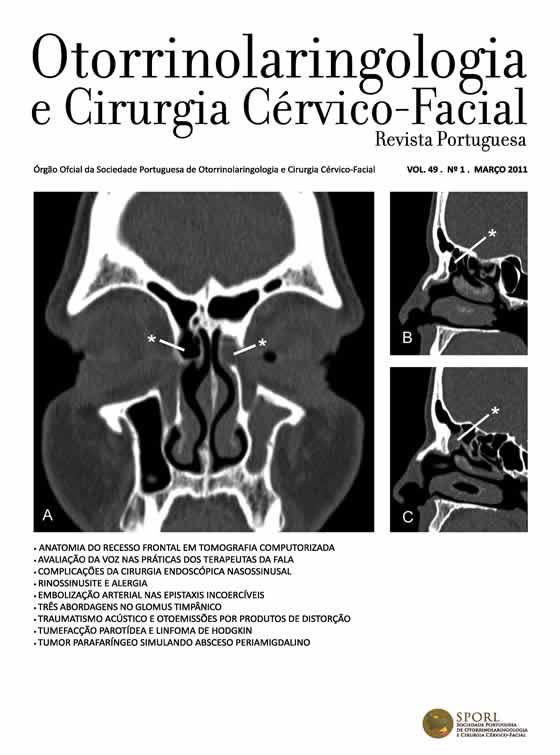Rhinosinusitis - allergy contribution
DOI:
https://doi.org/10.34631/sporl.149Keywords:
rinite alérgica, testes cutâneos prick, allergic rhinitis, skin prick tests, ARIAAbstract
Objectives: Evaluation of demographic characteristics, symptoms, allergen sensitization and treatment, in patients complaining of nasal obstruction referred to immunoallergology with suspected allergic rhinitis.
Material and Methods: Retrospective analysis of case reports of patients ( 1 October 2005 - 30 September 2006).
Results: 53 patients were referred, with 24% reporting history of allergic diseases. The most common symptoms were nasal obstruction (88%) and the anterior rhinorrhea ( 78%). Sixty one per cent of patients had allergic rhinitis. Only 1% of patients had no complaints after medical treatment. Diagnosis is confirmed with skin tests by prick and/or assay of specific IgE.
Conclusions: The clinical suspicion of allergic rhinitis is based on the collection of detailed clinical history and physical examination. Symptomatic treatment of these patients is difficult with the use of allergen avoidance and corticotherapy nasal and/ or antihistamines.
Downloads
References
Bousquet J, Van Cauwenberge P, Khaltaev N, ARIA Workshop Group. Allergic Rhinitis and Its Impact on Asthma. J Allergy Clin Immunol. 2001 Nov; 108(Supl 5):S147-334.
Horak F. Clinical advantages of dual activity in allergic rhinitis. Allergy. 2000; 55(Supl 64):34-9.
Annesi-Maesano I, Didier A, Klossek M., Chanal I. et al. The score for allergic rhinitis (SFAR): a simple and valid assessment method in population studies. Allergy. 2002 Feb;57(2):107-14.
Rozsasi A, Leiacker R, Keck T. Nasal conditioning in perennial allergic rhinitis after nasal allergen challenge. Clin Exp Allergy. 2004 Jul;34(7):1099-104.
Price D, Zhangw Q, Kocevarw V, Yinw D, et al. Effect of a concomitant diagnosis of allergic rhinitis on asthma-related health care use by adults. Clin Exp Allergy.2005 Mar;35(3):282-7.
Plaut M, Valentine MD. Allergic rhinitis. N Engl J Med. 2005 Nov 3;353(18):1934-44.
Kern EB. Committee report on standardization of rhinomanometry. Rhinology. 1981 Dec;19(4):231-6.
Ciprandi G, Cirillo I, Vizzaccaro A, Milanese M, et al.Nasal obstruction in patients with seasonal allergic rhinitis: relationships between allergic inflammation and nasal airflow. Int Arch Allergy Immunol. 2004 May;134(1):34-40. Epub 2004 Mar 25.
Camargos P, Ibiapina C, Lasmar L, Cruz AA. Obtaining concomitant control of allergic rhinitis and asthma with a nasally inhaled corticosteroid. Allergy. 2007 Mar;62(3):310-6.
Juniper EF. Measuring health-related quality of life in rhinitis. J. Allergy Clin. Immunol. 1997 Feb;99(2):S742-9.
Crystal-Peters J, Crown WH, Goetzel RZ, Schutt DC. The cost of productivity losses associated with allergic rhinitis. Am J Manag Care. 2000 Mar;6(3):373-8.
Spector SL. Overview of comorbid associations of allergic rhinitis. J Allergy Clin Immunol. 1997 Feb;99(2):S773-80.
Didier A, Chanal I, Klossek JM, Mathieu J. La rhinite allergique: le point de vue du patient. Rev. fr. Allergol .1999 Mar; 39:171–185.
Kuprys I, Elgalal A, Korzycka-Zaborowska B, Gorski P, et al. Underdiagnosis of allergic diseases in the general population of Lodz province. Allergy. 2002 Jully; 57: Suppl.73, 185.
Sibbald B, Rink E. Labelling of rhinitis and hayfever by doctors. Thorax. 1991 May;46(5):378-81.
Bauchau V, Durham SR. Prevalence and rate of diagnosis of allergic rhinitis in Europe Eur Respir J 2004 Nov;24(5):758-64.
Hansel F. Clinical and histopathologic studies of the nose and sinuses in allergy. J Allergy 1929 Nov;1:43–70.
Bousquet J, Khaltaev N, Cruz A, Denburg J, et al. ARIA Update; Allergy. 2008 Apr. 63(Supl 86):7
Morais-Almeida M, Nunes C, Gaspar A, FalcãoH, e tal. Rinite em Idade Pré-escolar: prevalência e caracterização, estudo ARPA KIDS; Rev Port Imunoalergologia. 2007 Set. 15:387-410.
Nunes C, Ladeira S, Rosado JE. Definição, epidemiologia e classificação. In Rosado-Pinto JE, Morais-Almeida M. (Eds). A criança Asmática no Mundo da Alergia. Edições Médicas LDA; 2003:35-55.
Todo-Bom A, Loureiro C, Morais-Almeida M, Nunes C e tal. Epidemiology of rhinitis in Portugal; evaluation of the intermittent and persistent types. Allergy. 2007 Sept;62:1038-43.






